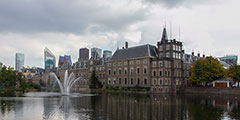Binnenhof, 2513 AA, The Hague
In and around the parliament buildings, we find milestones of the tradition of The Hague as City of Peace and Justice. These are connected with the work of the 17th century lawyer Hugo Grotius and, not to forget, the action of his wife Maria Reigersberg.
„We were laying a foundation, though for what we didn’t yet know“
– Leymah Gbowee (Nobel Peace Prize 2011)
The old name ’s Gravenhage (Counts‘ Woodlands) refers to the 13th century summer castle of the Counts of Holland. In the late 16th Century, the Inner Court (Binnenhof) became the seat of the Parliament of the Republic of the United Netherlands. The Hall of Knights (Ridderzaal), built in 1640, has remained the symbol of Dutch democracy until now.
The Prison Gate at the Outer Court (Buitenhof) is the former prison of the Court of Holland, now part of the Hague Historical Museum. Hugo Grotius (1583-1645) started his legal career as a 16 year old lawyer in The Hague, since 1607 as an attorney at the court. In these years he wrote his treatise Mare Liberum (Freedom of the Sea, 1609) against the crime of piracy. In 1618 Grotius was locked in the Prison Gate himself as a peace dissident and transferred to the heavily guarded Loevestein castle. His wife Maria Reigersberg managed to let him escape in a book trunk, as immortalized by the 17th century poet Joost van den Vondel:
„One woman is too strong for one thousand men!
O eternal honour of Reigersberg!!“
Grotius‘ main work De Jure Belli ac Pacis (On the law of war and peace, 1625), written in exile in Paris, became a guideline for the 19th century pacifist movement. In his spirit, Tobias Asser opened in 1893 the first Hague Conference on Private International Law in the Hall of Truce (Trêveszaal). The work on peace issues started in 1894 at the conference of the Inter-Parliamentary Union in the Hall of Knights, where the Austrian peace activist Bertha von Suttner was the first woman to enter this male political stronghold. She was also a driving force behind the Hague Peace Conferences of 1899 in Palace ‚House in the Woods‘ (Huis ten Bosch) and of 1907 in the Hall of Knights.
The main result, the creation of the Permanent Court of Arbitration, is still remembered as a ‚Grotian moment‘. Thus, on 4 July 1899, the US delegation led a pilgrimage to Grotius’ tomb in the city of Delft. The Peace Palace was opened on 28 August 1913, the day of his death in 1645. At the centenary celebration of 28 August 2013 the Liberian peace activist Leymah Gbowee (Nobel Peace Prize 2011) spoke in The Hague and Delft in the spirit of Reigersberg and Von Suttner: „It is time for reflection, how do we go back a hundred years, rethink how peace is done.“






 11 minuten via Plein & Tournooiveld
11 minuten via Plein & Tournooiveld